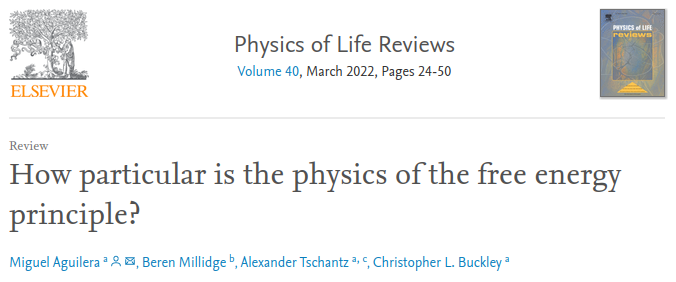Miguel Aguilera complex systems, neuroscience and cognition
How particular is the physics of the free energy principle?

In a new paper in Physics of Life Reviews I present a deep mathematical exploration of the free energy principle (FEP) in collaboration with Beren Millidge, Alexander Tschantz and Chris Buckley. The FEP has gained an important momentum as an ambitious theory aiming to provide a unifying theory of mind and life, explained in terms of approximate Bayesian inference. However, there is not many examples of applicaitons of the theory to specific systems, and recent technical critiques had questioned the genereality of its underlying assumptions.
By analytically solving a family of linear nonequilibrium systems we explored the necessary steps to derive the claims of the FEP, finding to main problems of the theory in its current form:
- Some of the assumptions about the required statistical properties of the target system (e.g. Markov blankets) arise only for very narrow regions of the parameter space. Thus, the plausibility of the FEP is dependent on the assumption that biological systems can operate in a non-trivial regime.
- The main result of the FEP, that describes the behaviour of a system as minimizing a variational free energy, is in general a poor description of the behaviour of a system as it ignores the history of interactions (i.e. the previous trajectory) of a system, as it relies on an implicit equivalence between the dynamics of the average states of a system with the average of the dynamics of those states.
These issues suggest that the claims of the theory should be taken with caution, and that more development is needed before it can be applied to understand living and cognitive processes.
Aguilera, M, Millidge, B, Tschantz, A & Buckley CL (2022). How particular is the physics of the free energy principle?. Physics of Life Reviews 40:24-50; https://doi.org/10.1016/j.plrev.2021.11.001
Abstract
The free energy principle (FEP) states that any dynamical system can be interpreted as performing Bayesian inference upon its surrounding environment. Although, in theory, the FEP applies to a wide variety of systems, there has been almost no direct exploration or demonstration of the principle in concrete systems. In this work, we examine in depth the assumptions required to derive the FEP in the simplest possible set of systems – weakly-coupled non-equilibrium linear stochastic systems. Specifically, we explore (i) how general the requirements imposed on the statistical structure of a system are and (ii) how informative the FEP is about the behaviour of such systems. We discover that two requirements of the FEP – the Markov blanket condition (i.e. a statistical boundary precluding direct coupling between internal and external states) and stringent restrictions on its solenoidal flows (i.e. tendencies driving a system out of equilibrium) – are only valid for a very narrow space of parameters. Suitable systems require an absence of perception-action asymmetries that is highly unusual for living systems interacting with an environment. More importantly, we observe that a mathematically central step in the argument, connecting the behaviour of a system to variational inference, relies on an implicit equivalence between the dynamics of the average states of a system with the average of the dynamics of those states. This equivalence does not hold in general even for linear stochastic systems, since it requires an effective decoupling from the system’s history of interactions. These observations are critical for evaluating the generality and applicability of the FEP and indicate the existence of significant problems of the theory in its current form. These issues make the FEP, as it stands, not straightforwardly applicable to the simple linear systems studied here and suggest that more development is needed before the theory could be applied to the kind of complex systems that describe living and cognitive processes.
Written on March 17th, 2022 by Miguel Aguilera